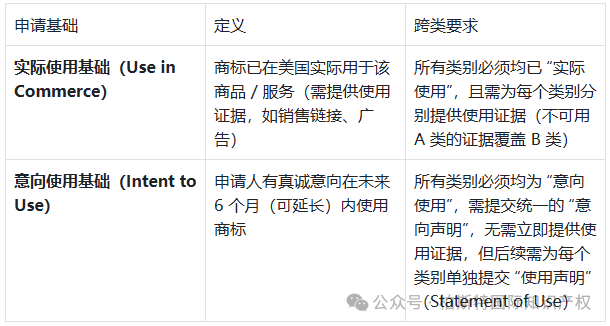- Knowledge
1. Clarify the core attributes of goods/services
First, determine whether your trademark will be used for "goods" or "services", and then refine the specific category:
Example 1: If selling "handmade soap"
The core attribute is "physical goods", corresponding to Class 3 (cosmetics, cleaning agents), similar to the group "0301" (soap, soap, and other cleaning products).
Example 2: If providing "online clothing retail services"
The core attribute is "service", corresponding to category 35 (advertising, business management, retail services), similar to the group "3503" (promoting for others), rather than category 25 (clothing products) - note that "selling clothes" (services) and "producing clothes" (products) belong to different categories.
2. Refer to USPTO's "Official Classification Database"
The US Trademark Office has not completely copied the original name of the Nice classification, and the classification of some goods/services may differ slightly from the international version, requiring precise matching through the following tools:
Official tool: USPTO Trademark ID Manual(https://www.uspto.gov/trademarks/search/trademark-id-manual )
Enter keywords for products/services in the search box (such as "yoga mat" or "online education"), and the system will recommend corresponding "classification numbers similar to group standard descriptions". Prioritizing the official recommended "standard descriptions" can reduce the risk of review rejection (avoiding being required to make corrections by USPTO due to vague descriptions).
3. Avoid "overly broad" or "irrelevant choices across categories"
Prohibition of "symbolic selection": If only "coffee cups" (Class 21) are sold but "jewelry" (Class 14) is additionally selected, USPTO will reject the application for "lack of sincere intention to use" and may affect the overall credibility of the application.
Allow 'association selection': If the brand is involved in both 'physical backpack sales' (Class 18) and' backpack customization services' (Class 40), both related categories can be selected simultaneously, but corresponding usage evidence (such as sales records and customization contracts) must be provided separately.
4. Key note: "Similar group associations"
Different similar groups under the same category may not necessarily have similar products/services, and it is necessary to determine whether there is a degree of correlation:
Example: In Class 9 (electronic devices), although "0901" (computers) and "0919" (security monitoring devices) belong to Class 9, USPTO considers that the two have significant differences in functionality and use, and do not belong to "similar goods". If both categories of goods need to be protected, they must be clearly listed in the application.

If the foundations are inconsistent, separate applications must be submitted: for example, if Class A (clothing) has been actually used and Class B (luggage) is only intended for use, two separate applications (one for "actual use" and one for "intended use") must be submitted and cannot be merged.
2. "Cost and Review" of Cross Category Applications
Cost: USPTO charges based on the "number of categories". If one application contains N categories, a "basic application fee (N-1) additional category fees" must be paid (2024 standard: electronic application basic fee of $250/category, which means one application containing 2 categories requires $500, consistent with the total cost of submitting 2 separate applications).
Examination: All categories will be examined separately by USPTO examiners (different categories may be assigned to different examiners). If a category is rejected due to "similarity to prior trademarks", it does not affect the examination results of other categories (the rejected category can be defended separately, or the category can be abandoned and other approved applications can be retained).
3. Special circumstances: "Scenarios that must be applied for separately"
If the following situations exist, even for related categories, separate applications need to be submitted:
① Different categories correspond to different "applicants" (such as Company A applying for Category 3 cosmetics and Company B applying for Category 35 retail services, which need to be separated);
② Different categories correspond to different "trademark styles" (such as using colored logos for Class 25 and black and white logos for Class 35, which need to be separated);
③ Some categories need to be extended to the United States through the "Madrid System", while others need to be submitted directly to USPTO (with different application channels, they need to be separated).
3、 Practical suggestion: Reduce the risk of cross class application
1. Prioritize 'core category association category':First, protect the core categories currently in use (such as applying for categories 29 and 30 for the sale of "organic food"). After the business expands, add categories through "Supplementary Registration" or "New Application" to avoid delays in the initial selection of categories.
2. Strictly match 'evidence of use':If "actual usage basis" is used for cross category, the evidence for each category must be clearly corresponding (for example, the evidence for the 35th category of retail services can be screenshots of e-commerce platform stores, and the evidence for the 40th category of processing services can be processing contracts), and cannot be mixed.
3. Search for "cross class similar trademarks":Before applying, it is necessary to search for all prior trademarks in the target category through USPTO's "Trademark Electronic Search System (TESS)" to avoid affecting the overall application due to the existence of similar trademarks in a certain category (even if there are no conflicts in other categories, the rejected category will increase time costs).
Chinese reference table for the classification of Ennis

That's all for today's content sharing
If you have any other questions regarding intellectual property rights
Feel free to leave us a message anytime, and we will continue to answer your questions~~~




